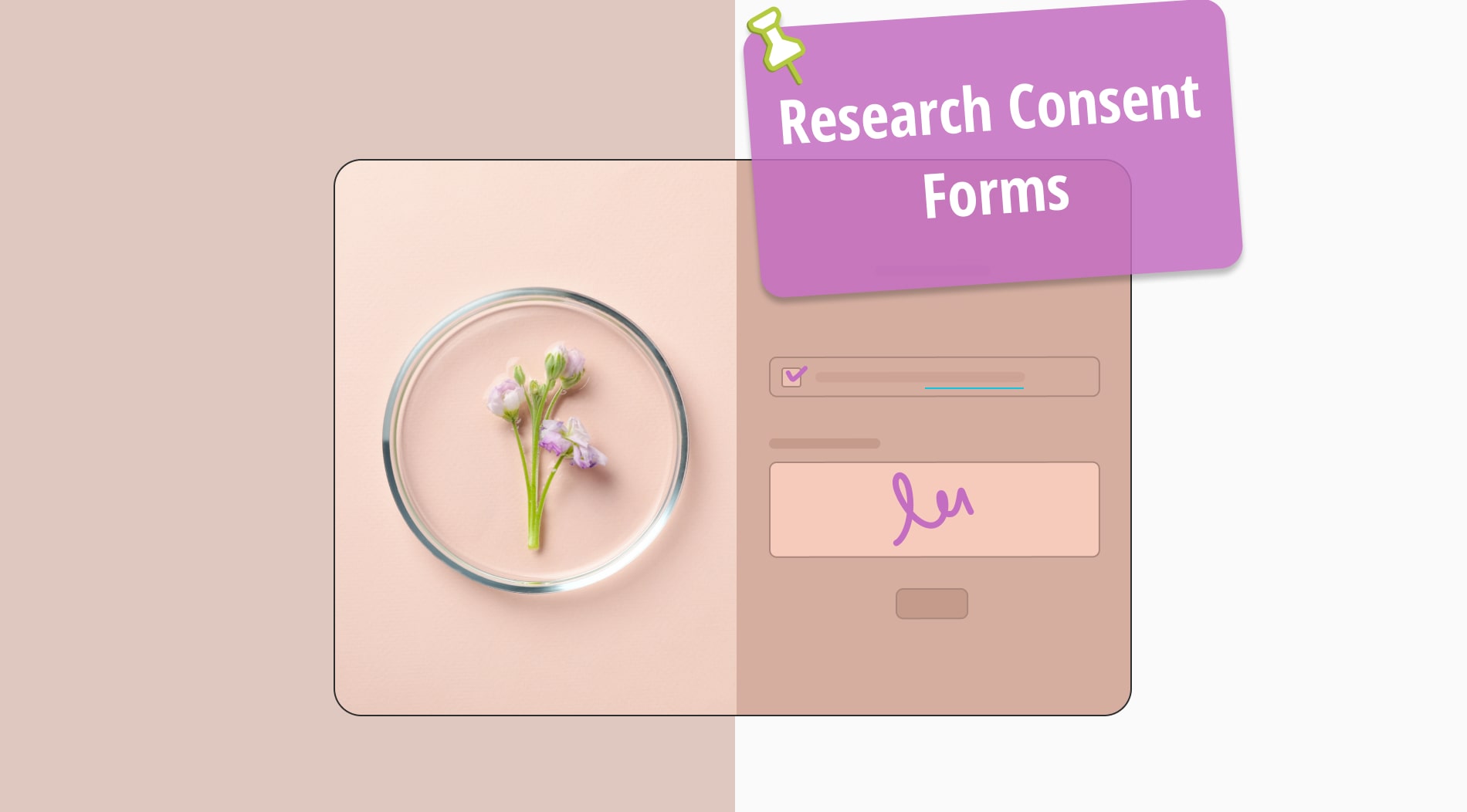Collecting data is the backbone of academic research and studies. We can safely say that the data collected determines the results and the accuracy of the academic work. When data collecting is in question, things can get a bit tricky because people in the study may need to divulge personal information.
An online research consent form is essential when collecting personal or private information to use as bulk data in your study in order to state the purposes of the data collection and reassure the people. In this article, we are gonna find out useful information as to how to create an online research consent form and which free tools are at your disposal.
What is a research consent form?
A research consent form is a document providing the potential participants with the nature and details of a study, informing them of their voluntary involvement.
It also highlights that they give their consent for sharing the mentioned data and that they reserve their right to withdraw from the study. Furthermore, it ensures that the data shared by the participant and to be used for the research is confidential and will be disclosed to specified parties only.
When do you need a research consent form?
A research consent form may be very useful when a study involves human participants. It is the ideal way to prove the participants understand the purpose, risks, and benefits of your study and agree to participate in it of their own accord.
- An academic research
- A study for a commercial campaign
- Surveys/Questionnaires
- Clinical Trials
You should also bear in mind that this document proves the fact that you followed the right steps and came by the data to support your research without any unethical conduct, helping you avoid any legal problems or accusations you may face in the future.
Why use an online research consent form?
A research form can be in a printed or online format, depending on the purpose of the study or the author of the document. However, creating and using an online research consent form is more advantageous than a printed form, as online forms:
- are more accessible to the audience,
- eliminate any printing or mailing costs,
- are more dynamic when editing or revision is needed,
- enable tracking the responses in real-time.
Many useful examples of consent forms are available online. They vary from sample consent forms for research surveys to templates of consent forms for research interviews. You can always create and customize research consent form examples in forms.app, creating your own best consent form format for your research.
How can you create a custom consent form for your research?
Every research/study has different parameters and variants, requiring different types of data to be collected. This means the consent form should also be customized to get maximum accuracy and efficiency. An online consent form will facilitate customization with more options in terms of both content and format. Let’s see how to create an online and custom consent form for your research:
1. Choose how you like to start
Choose a template or start from scratch. You can start by customizing the free research consent form template provided by forms.app, enabling you to utilize a great deal of features, i.e., a variety of form fields, conditional logic, and themes for your consent form.
If you do not want to start from scratch, forms.app has other solutions for you. You can use forms.app AI to create a base for your consent form. Just type what you want to see in your form, and then continue working from there. Everything is easier with AI these days.
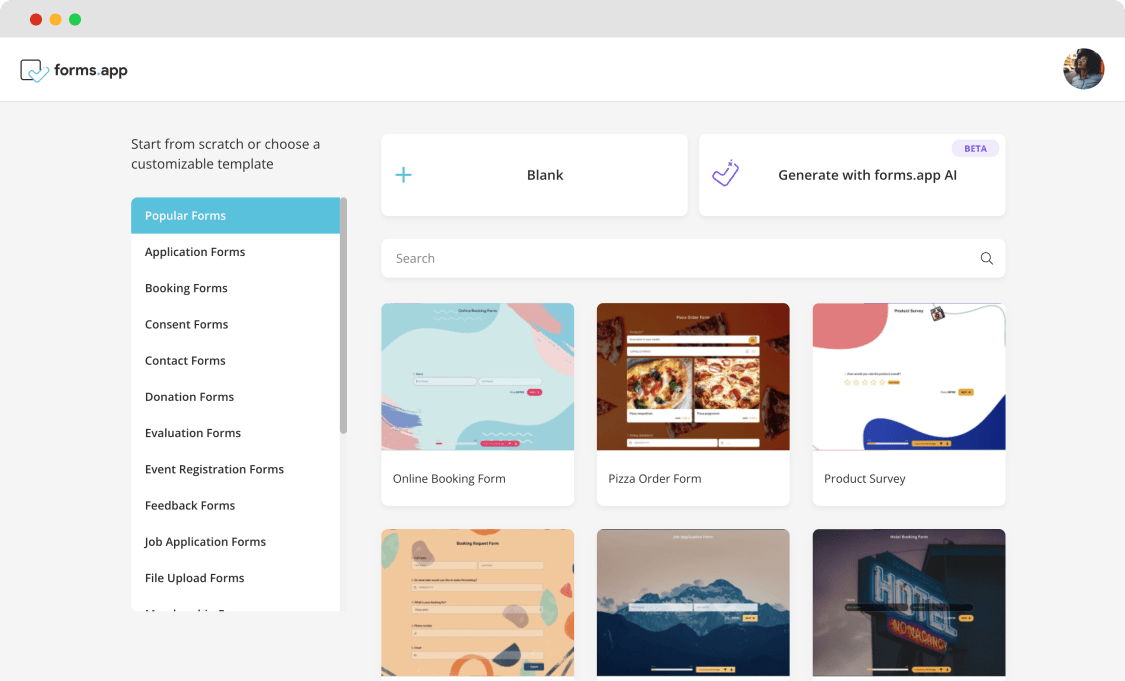
Choose a way to start
2. Add questions/fields to get consent
It is up to you to make it an original research consent form for your study by adding different questions/form fields such as cover, logo, text, multiple or drop-down selections, signature field, etc. All this can vary according to the preferences of the persons/institutions collecting different kinds of consent.
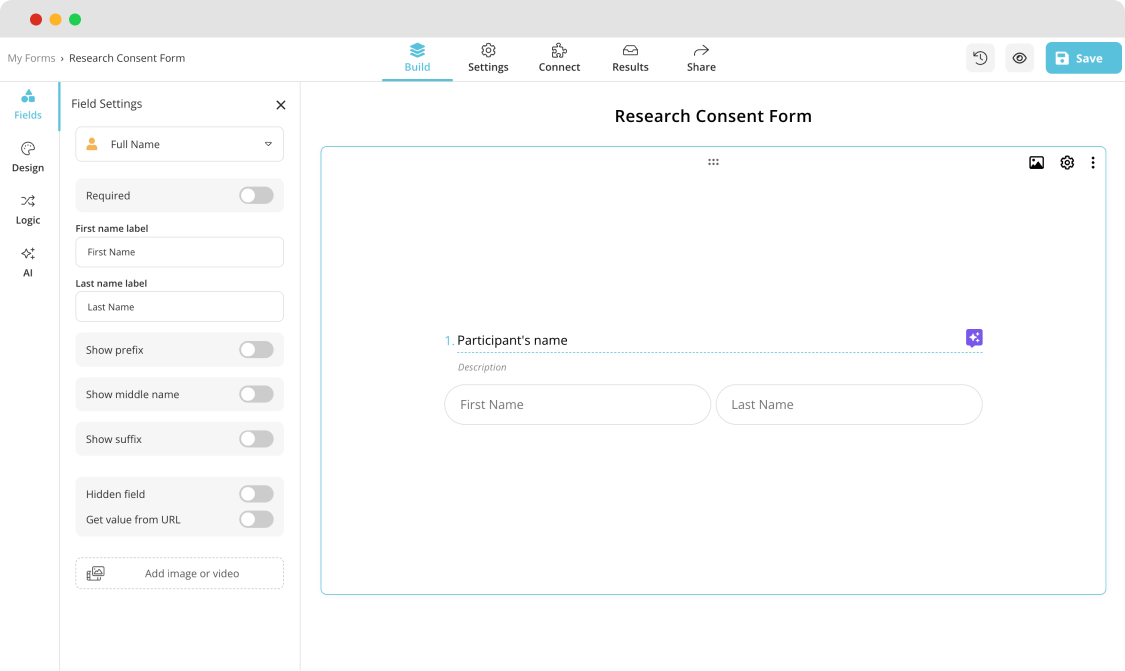
Add your questions
3. Customize the form according to your study/research
Your form will look smoother and work better with the colorful themes to dynamic types of questions, various interactive form fields, useful conditions, and custom warning messages, all offered free by forms.app to you! Make sure to customize the template to suit the purposes of your research/study.
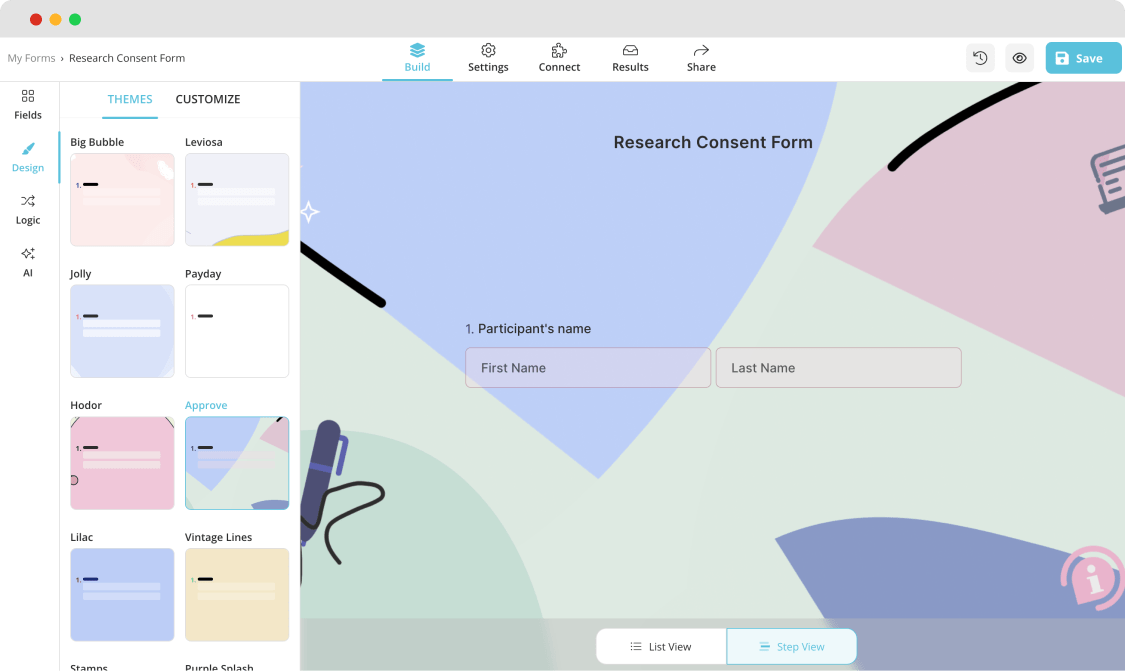
Customizing the design of your form
4. Share your form and gather consent
When your form is ready to go after customization, you can share it with the participants of your research/study and start gathering consent to divulge information. You do not have to print it out and distribute though. You can share it via e-mail, send the link out, or even embed it on your website with different options for views.
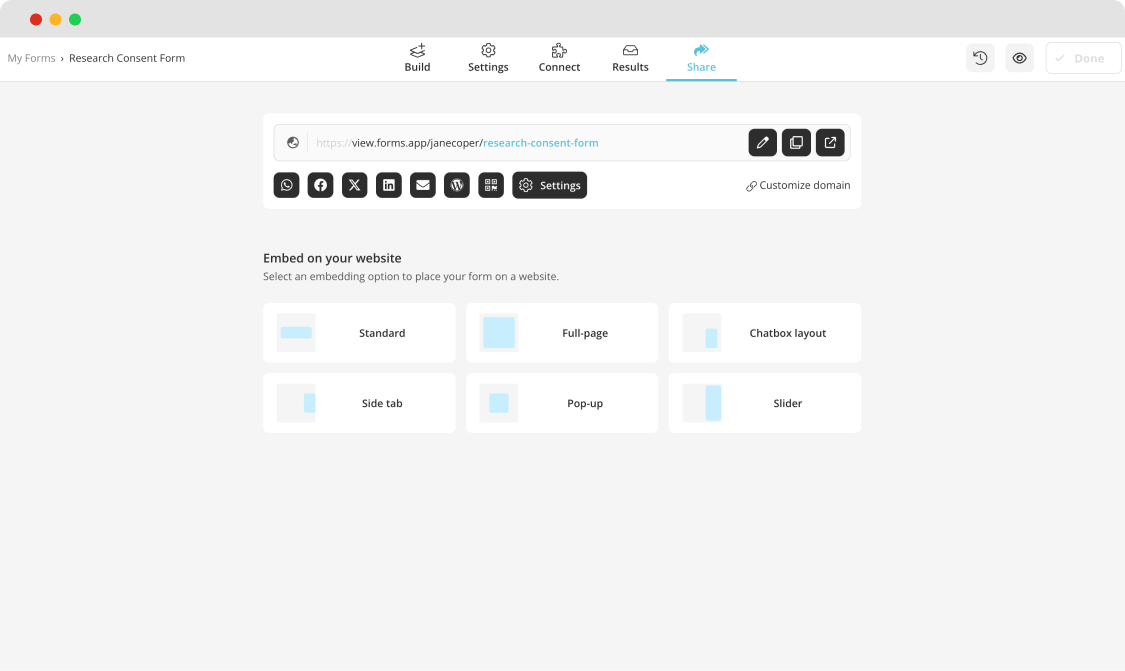
Share your consent form
What should be included in a research consent form?
The content of your research consent form should clearly state your purposes for gathering the consent of participants to avoid any kind of legal or academic problems. It should outline the study’s purpose, the potential risks/benefits, assurance of privacy, and the participant’s right to withdraw. You can also check out the guide to consent forms provided by forms.app.
A standard consent form can consist of the following sections:
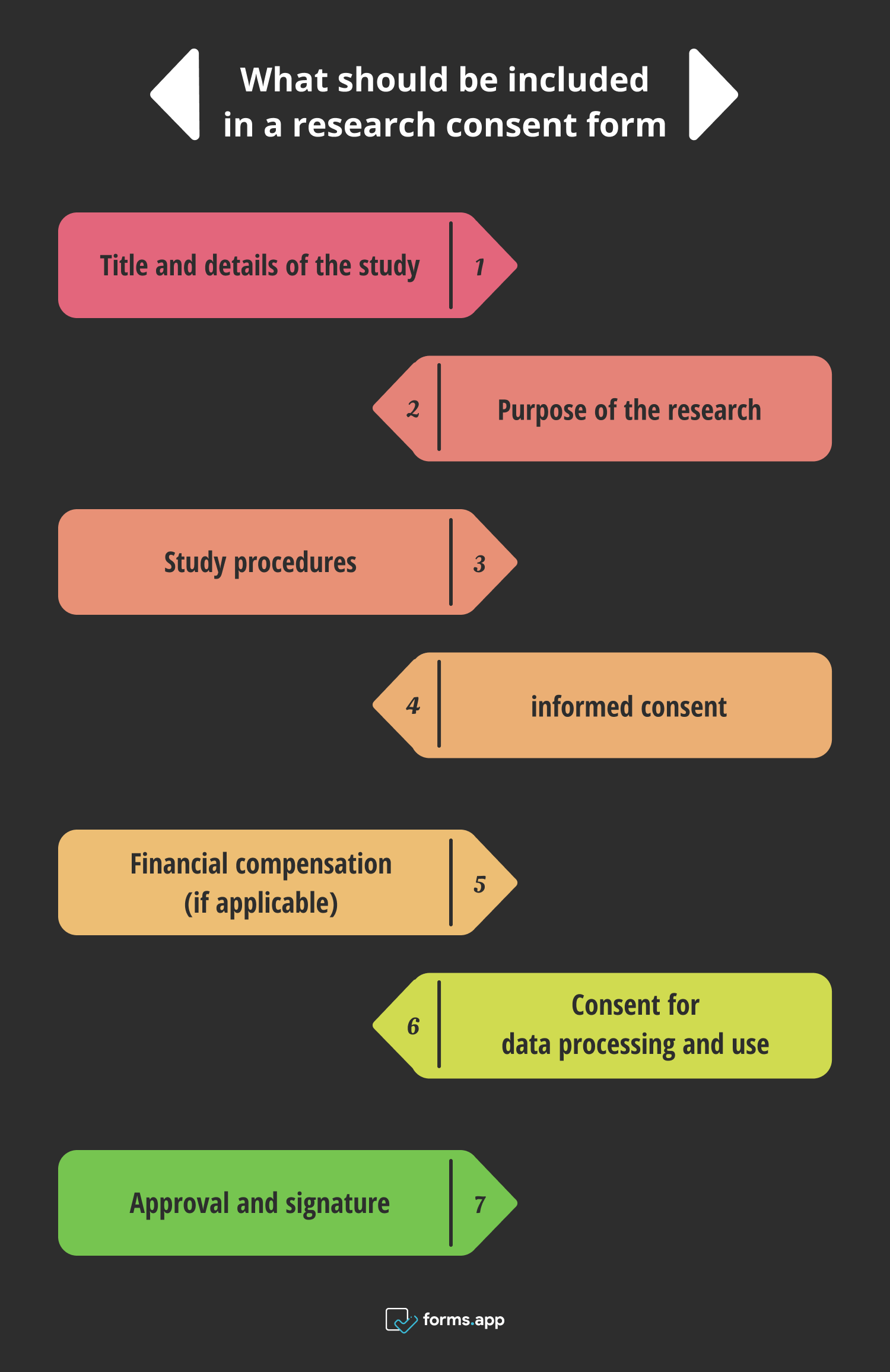
Things to consider while creating a research consent form
✅Title and details of the study: Write the title of the study alongside the details, such as the duration or participant eligibility.
✅Purpose of the research: Provide a brief introduction informing on the research/study purpose.
✅Study procedures: You should describe the study procedures in detail and include any risks that may occur during the research/study, as well as the benefits the participants may receive.
✅Informed consent: Explain in plain language that the participants are being asked to participate in a study and that they are giving their consent to participate and give out information. You should also indicate that this is a voluntary practice, and the participants can ask questions and seek clarification regarding a matter and have the right to withdraw.
✅Financial compensation (if applicable): To avoid any claims in the future, it should be clarified in the consent form whether the participants are entitled/not entitled to any form of financial compensation.
✅Consent for data processing and use: The participants might want to know how the data obtained by/through them will be used, and it may be an important factor in giving consent. Explain the type of data and how it will be used.
✅Approval and signature: This is a significant part of the form where the participant acknowledges that they read and agree with the statements in the form and approve it by putting their signature.
7 Tips to create a better online research consent form
So far, we have covered how to create and customize a research consent form. It is now easier for you to create and customize a standard online research consent form. However, if you want to be one step ahead, here are 7 tips for creating a better online research consent form that will make your job easier.
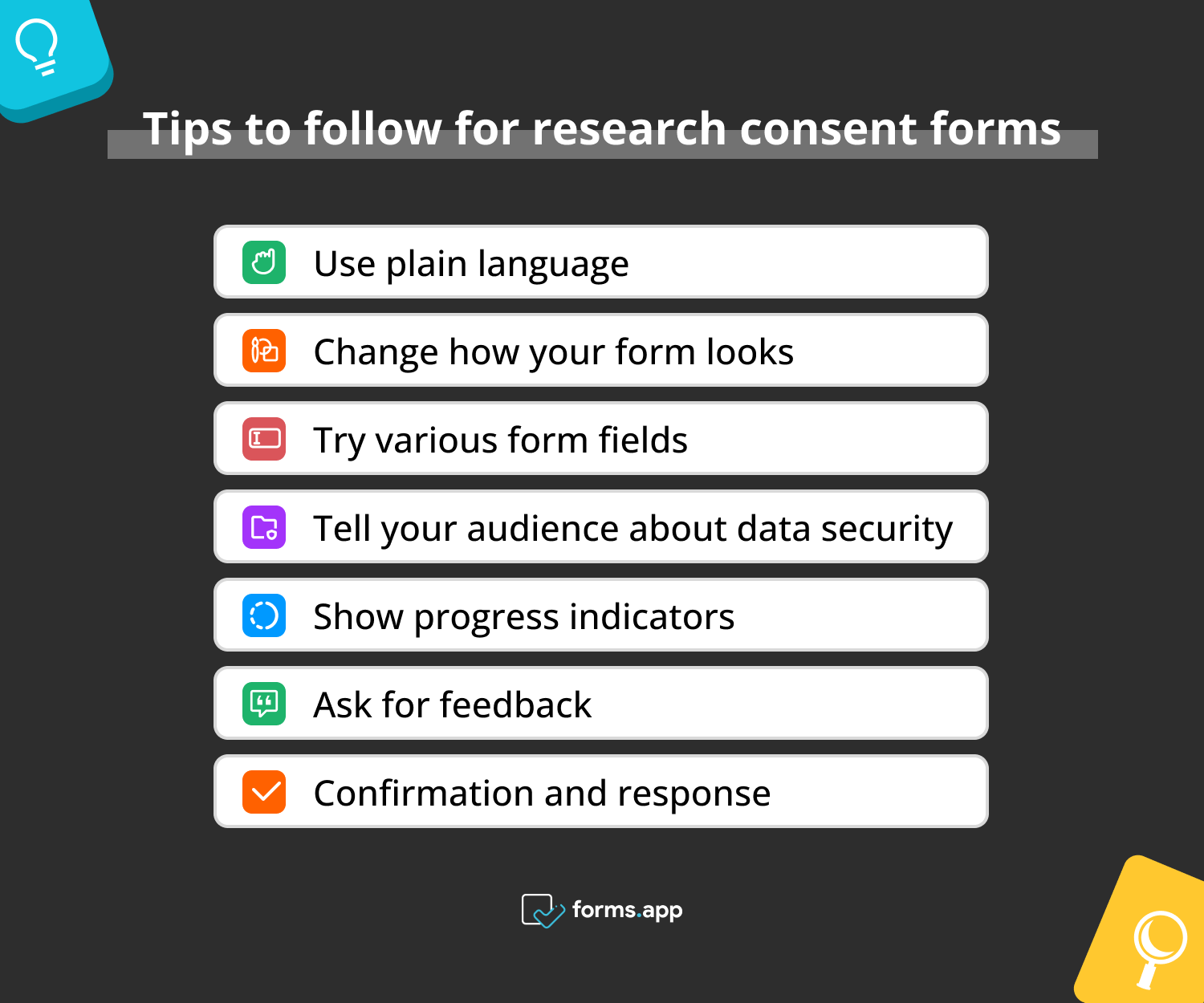
Tips to consider while creating research consent forms
1. Use plain language
Use clear and plain language that can easily be understood by your participants. Remember that your participants are not necessarily familiar with the technical terms and procedures of your research.
2. Change how your form looks
You can include images, icons, or visually attractive layouts that promote readability and give out a positive message about your research/study. A good-looking form enhances readability and clarity, ensures comprehension of critical information, and promotes informed consent.
3. Try various form fields
Create your form online with dynamic form fields. Rather than using plain text, you can use clickable checkboxes or include signature fields for the participants to sign. You can always make your consent form more accessible and compatible across various platforms and devices.
4. Tell your audience about data security
You need to ensure the participants that the security measures are in place to protect their data. You can also indicate that the data is collected, stored, and processed in secure and private platforms.
5. Show progress indicators
Some forms can be long and complicated due to the nature of the research/study. Therefore, you can include progress indicators to show the participants how far they are from completing the consent process. On forms.app, your forms will have progress indicators on default settings.
6. Ask for feedback
Always leave room for improvement! You can create a field for participants where they can express their opinions and talk about their experiences while filling out your online consent form. It enables researchers to address potential errors and ambiguities and is a good channel for communication with the participants.
7. Confirmation and response
Last but not least, include a confirmation page affirming that the participant has completed the consent form and no further action is required. You can also enable email notifications to send a copy of the completed consent form to the participants as an e-mail.
To sum up
In conclusion, consent forms are an important part of research, and you can create an online and customized consent form that is better suited for your purposes by including required sections and better visuality.
In this article, you have seen what should be included in a standard online research consent form and how to be one step ahead by using a dynamic platform enabling various features and following through some handy tips. Now that you have learned everything about online research consent forms, you can visit forms.app and create yours!
Fatih is a content writer at forms.app and a translator specializing in many text domains, including medical, legal, and technical. He loves studying foreign languages. Fatih especially likes to create content about program management, organizational models, and planning tools.
